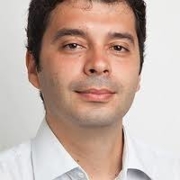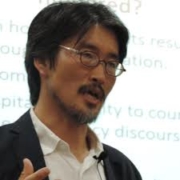Peter Cave
Educational change (or not) in Japan
You’ve probably heard about the elaborate Olympic handover from Rio to Tokyo that included a video animation of Super Mario walking through Shibuya, jumping through a green tube, and then appearing at the closing ceremony in Rio. The super Mario custom dropped to the floor and there was, lo and behold, Japanese Prime Minister Shinzo Abe, standing in a red hat holding a red ball, ready to take the helm of the Tokyo Olympics, which will take place in 2020. It was an unusual moment, to say the least, for the Japanese leader, who is typically reserved and anything but showy.
But the scene perfectly captured the contemporary push by the Abe administration to internationalize Japan. There he was in front of a global audience, showing off Japan’s athletes and pop-culture icons. Abe has been on a march to change Japan: he’s trying to alter the constitution to allow Japan to send military forces abroad, something that has not been done since World War II. And his administration started something called super-global universities, which aim to allow graduates to “walk into positions of global leadership.”
Reforms to Japanese education are not knew and we can learn a lot by looking at previous experiences. My guest today, Peter Cave, has a new book that explores changes in Japanese junior high schools in the 1990s and in the early 2000s.
Dr. Peter Cave is a Senior Lecturer in Japanese Studies at the University of Manchester. Through an ethnography of two schools over 11 years, he was able to detail how, if at all, educational reforms translated into educational practice.
And these insights can help us understand the reforms being proposed today by the Abe administration.
Peter Cave’s new book is “Schooling Selves: Autonomy, Interdependence, and Reform in Japanese Junior High Education”, which was published this year by the University of Chicago Press.
Citation: Cave, Peter, Interview with Will Brehm, FreshEd, 39, Podcast audio, August 28, 2016. https://freshedpodcast.com/petercave/
Will Brehm 0:01
Peter Cave, welcome to FreshEd.
Peter Cave 2:23
It’s good to be here. Thank you.
Will Brehm 2:26
Why is Japanese junior high school a valuable place to look at when trying to understand the changes in Japanese education?
Peter Cave 2:36
Well, first of all, junior high school is a pivotal stage of education in Japan. The Japanese school system has six years of elementary school, three years of junior high school, three years of high school. Elementary and junior high are compulsory and over 90% of children go to their local public junior high school without any entrance exam. So, the first major exam and the sorting point for most Japanese children is the high school entrance exam at age 15 at the end of junior high school. So, that’s one reason why it’s an important stage of education to look at. It’s also, for the purposes of this particular set of reforms that I look at in my book, it’s valuable to study because the changes that took place in the 1990s and 2000s were more of a challenge to junior high schools than to other stages of education. They did affect elementary schools as well, but they were more in tune with the existing styles of education at elementary school, whereas projects style and student-centered learning was a much newer thing at junior high schools. And so it was, if you like, a key test of whether the reforms would be successful.
Will Brehm 4:07
Let’s talk about these two different decades of reform that you’re referring to. So, what happened in the 1990s? What sort of reforms took place that changed, or tried to change, actions and practices at the junior secondary level?
Peter Cave 4:25
In the 1990s, reform was much more gradual in the sense there was no major changes to the content of the curriculum. There was a new emphasis introduced on student’s own interests, which schools were supposed to take account of. They were supposed to teach more with that in mind but that was about it. There were no new curricular domains or subjects introduced.
Will Brehm 5:00
And what about in the 2000s? What sort of reforms occurred then?
Peter Cave 5:08
So, this is where the really controversial reforms are introduced, I suppose. The really challenging reforms. So, in 1998, the government produced a revised curriculum which was implemented in 2002. And what happened there was, first of all, there was a full switch to a five-day school week. So, Japan had had a five-and-a-half-day school week up to the early 1990s. And it was gradually phased into a five-day school week, which came into effect in 2002. And then there was a change in the curriculum in that, first of all, the number of hours for conventional academic subjects were reduced by somewhere between 10% and 20%. And a new domain was introduced into the curriculum, which was called Integrated Studies, which gave schools a great deal of freedom to decide what they taught in those hours, there was about two or three hours a week. And they were supposed to teach in an innovative way that involves experiential learning and encouraged students to think for themselves, identify problems, solve problems for themselves.
Will Brehm 6:45
What was the logic behind the reforms that happened in the 2000s?
Peter Cave 6:53
There were two rationales, I suppose. The idea was that Japanese education was lacking in two major areas. So, first of all, it was thought there was not enough emphasis on children being encouraged to think for themselves, identify problems, solve problems for themselves. And it was thought these are qualities that were going to be needed in the 21st century. And so, education had to develop them more. So, that was the first thing. The second thing was that it was thought that children were lacking in social and emotional skills if one can put it in that way. And there, the problem was thought to be that these kinds of skills were things that, it was thought at any rate, children used to learn outside school, at home or in their neighborhood. But as society changed and children were spending more sedentary lives, they’re spending more time studying in tutorial colleges, or playing their computer games, or whatever it was. They weren’t spending enough time with other people and so schools had to do more to foster those sorts of abilities.
Will Brehm 8:35
And these rationales, they existed at the national level, because in Japan there’s a National Ministry of Education that can set policy for schools around the country.
Peter Cave 8:48
That’s right.
Will Brehm 8:50
And so that gives the ministry quite a lot of power, in a sense.
Peter Cave 8:54
Yes. So, as you say, it’s a national system. It’s not a federal system as we see in some other countries.
Will Brehm 9:02
In your book, you talk about this idea that was found in the reforms that was titled “the power to live”. What did that concept mean?
Peter Cave 9:14
So, the power to live is a sort of label which really refers, I think, to those two sets of qualities that I was talking about before. On the one hand, the intellectual curiosity, the creativity, the ability to think for yourself. On the other hand, the sort of social and emotional skills. So, it’s a label that’s supposed to encompass all of those different things.
Will Brehm 9:47
And there’s also an interesting dichotomy, or dialectic, between the ideas of individual and groups found in some of these reforms. Can you describe this sort of dialectic?
Peter Cave 10:03
Yeah, well, this is quite complicated. So, there has always -well, I don’t know about always, but certainly, during post-war education- there has been emphasis in some sense on both individuals and groups in Japanese schools. So, the emphasis on the groups is quite well known, I suppose. So, there is a lot of emphasis on group activities of various kinds that are supposed to help children to learn to work together and cooperate. But the emphasis on the individuals, I suppose, mainly comes particularly in secondary education because children are evaluated as individuals. So, they take exams, they’re assessed as individuals. But what’s important to understand is that doesn’t necessarily mean you’re being educated to be autonomous. Because being autonomous means that you decide for yourself what you study. Of course, you’re not doing that under many exam systems because what you study and what you do is laid down for you. What is expected of you is self-reliance, which means that you have to have the motivation to do what you’re supposed to do. In other words, what other people are telling you. Now, what happens with the reforms introduced in 2002, and to some extent, the new emphasis that was introduced from the 1990s onwards, is there is supposed to be more emphasis on autonomy. There is supposed to be more emphasis on thinking for yourself, developing the ability to think for yourself, deciding for yourself what you’re going to be studying. So, in that sense, it’s a different sort of emphasis on the individual than you’d seen before.
Will Brehm 12:17
Would you say that the rise of the discourse on individualism can be attributed to some of the thinking around neoliberalism?
Peter Cave 12:31
Well, the first thing I would say is, I don’t like the word individualism because I think it’s a really confusing word. I’m not really sure what it means. So, I don’t like to use that word. I mean, in a very broad sense -and I really want to emphasize, it is only a very broad sense- perhaps you can associate these reforms with neoliberalism in the sense that, as I said before, one reason they were put into effect was the idea that Japan was going to need more people to be able to be more creative and to think for themselves more because society would be changing very rapidly. It was envisaging increasing innovation in the 21st century. So, if that is associated with neoliberalism, then perhaps you can say there is an association. But I want to be quite cautious about that because it seems to me that the idea of encouraging students to think for themselves and what you might call student-centered learning, that sort of thing, I don’t see a necessary connection with neoliberalism. And in many countries, of course, those sorts of ideas about how education should be done have very long histories. You know, you can go back to John Dewey, for goodness’ sake. So, I mean, I don’t think people would say that John Dewey was neoliberal -who knows? So, I think we have to be very cautious about making that sort of association.
Will Brehm 14:23
So, in the early 2000s, Japan came out on top of some of the international testing that was being done and today it’s known as PISA. How did those results work with some of the reforms that were coming out around that same time?
Peter Cave 14:44
Well, the very first PISA tests which were done, I think, in 2000, didn’t really have any effect because the reforms had already been proposed. They’ve been proposed in 1998, they were coming into effect in 2002. And I guess they just, if anything, confirmed to the policymakers that Japan was doing fine in a conventional sense, and they could go ahead. What had a big effect were the second round of PISA tests in 2003 when the performance of Japanese children dropped a bit. Now, in most countries, I don’t think the drop would have been seen as any big deal. In fact, most countries would be delighted to come about fifth or six in maths, and I think it was second in science, which was where Japan was placed. But this was considered to be a bit of a disaster in Japan, and there were a lot of worries about dropping academic attainment, and a sense that this was not the right time to be cutting curricular content for conventional subjects. So, I think that actually caused a problem for the 2002 educational reforms. And already, even before the PISA tests, there was a lot of criticism that was being leveled at them because of a sense that conventional academic attainment as traditionally understood, in terms of knowledge, understanding, and proficiency in maths and so on might be threatened.
Will Brehm 16:51
So, let’s turn to your study because you actually did a lot more than just looking at policies and the broader context of these policies you actually performed, basically, ethnographies inside schools. Can you tell us a little bit about your study?
Peter Cave 17:11
Yes. So, it was a study that took place over some time. So, the very first time I went to study the schools, or one of the two schools that ended up being a focus was in 1994 for a couple of months. And then I spent a year at the school, which I call Tachibana in the book from ’96 to ’97. And then I made a number of short visits over the years. And then in 2007, I went back to Tachibana to one more school, which I call Yoneda and spent four months particularly focusing, at that point, on the implementation of Integrated Studies and other reforms that have taken place in the previous few years.
Will Brehm 18:12
So, in a sense, the first school that you performed the ethnography in in 1996 became a way for you to compare some of the reforms that were taking place by 2007. Is that what you were trying to do?
Peter Cave 18:30
That’s right. So, I was able to see how things had changed over the dozen years or so between the two studies. Yes.
Will Brehm 18:44
So, what did change? As a result of some of these reforms that you explained earlier, what sort of practices did you observe that changed or perhaps didn’t change?
Peter Cave 18:59
Well, I guess the interesting thing was, and in some ways, surprising thing for me, was more what didn’t change rather than what did change. So, as I said, this was quite a major curricular reform as far as junior high schools were concerned. They were introducing two or three hours a week in which they essentially could decide whatever they wanted to do more or less. And so, there’s, in a sense, huge opportunities. For many years, Japanese schools had been complaining about being controlled by the Ministry of Education, not having very much freedom to decide what they were going to do. And now, you know, this was all taken away in a sense, or at least it was alleviated. They had a lot more freedom. But in practice, the hours tended to be filled, to a significant extent, with existing activities. Activities that schools had been doing even before 2002. So, for example, they would spend the time doing preparatory study for the final year school trip. Or they would use the time for the cultural festival. Or they would use the time for activities such as workplace experience, for example. So, students would go and spend several days in local workplaces and do studies about that. Or another popular activity was they would research high schools that they might be interested in doing. So, there were some changes in the sense that there was more project learning introduced. There were more opportunities for students to do project learning. And it’s probably also true to say that, even though the changes were limited in that existing activities tended to get relabeled, there was more opportunity for students to do more investigatory research than before, but it was not as great of changes as perhaps might have been expected.
Will Brehm 22:03
You said that some of the activities were relabeled before and after these reforms. Can you give an example?
Peter Cave 22:11
So, yes. Workplace experience would be an example. So, that was something that schools were doing even in 1996. And what happened was that the length of the time that they did the workplace experience was extended. And there were more reflection, as it were, more preparation, more reflection would take place and students would do more presentations about what they’ve done. So, it’s more an expansion of what had already been done rather than something completely new.
Will Brehm 22:58
So, in a sense, the rhetoric on the national political level didn’t necessarily reflect. Like the level of crisis, perhaps, that was seen at the national political level wasn’t being reflected into some of the practices down at the school level?
Peter Cave 23:19
Yes, that’s right.
Will Brehm 23:22
And what about this issue of the individual? So, the big concern for the reforms in the first place being that students weren’t able to, quote unquote, think for themselves and lacked perhaps some sort of emotional capacity. How did those play out inside schools?
Peter Cave 23:47
I think it’s fair to say that as far as junior high school teachers were concerned, they tended to be much more concerned about the students’ supposed lack of social and emotional skills much more than supposed lack of the ability to think for themselves and to be creative. And so, what tended to happen was that schools would place more emphasis on activities that were designed to help children get on with one another, learn to cooperate and develop what you might call traditionally valued qualities. Schools were much more ambivalent about the issue of the individual, I think. In theory, they would always say that these are great ideas. Thinking for yourself and learning for yourself are great things. Creativity is very important. Nobody would ever deny that. But what they would say was, in the first place, “Is this really the stage of education where we should be focusing on these things? Isn’t junior high school the place where we should focus on the basics as it were? And is all this stuff about thinking for yourself and developing your individuality, is that something that we should be doing at this stage? Or should it be done rather later in the education system?” So, that was one thing they would often say. And they also felt ambivalence, I think, because as one teacher put it to me, how do you tell the difference between individuality and selfishness? When are kids just being selfish and wanting to have their own way, and when are they showing their individuality? And I think they had a lot of problems with that. And this was tied up to some extent with the long-standing problems that junior high schools in Japan have faced, and I’m sure this is not unique to Japan as far as lower secondary education is concerned. It’s always been the stage of education where there have been the most discipline problems. And so, the issue of keeping control and helping students deal with the various turbulences in their lives has always been something that junior high schools have been very focused on.
Will Brehm 26:48
And that’s probably because children at that age are going through huge transformations.
Peter Cave 26:54
Well, it’s all sorts of reasons. I mean, that’s one aspect of it but it’s also a time of social transformation if you like. So, it’s the point -as I said at the beginning of this interview- junior high school is really where children are realizing what their futures might be and that their future life path is starting to be determined. And they are realizing, I guess, what the reality of the future may be for them, which is also something that is going to have a big impact on the way they feel about things and the way they behave.
Will Brehm 27:43
I find it very interesting that some of the teachers and principals perhaps and school directors that you were working with, saw that thinking for yourself was a higher order skill that needed to be taught in later grades. I mean, sometimes I would think that this is something that actually should be taught maybe at lower grades in primary school and elementary schools.
Peter Cave 28:12
Well, yeah, it is really strange, in a way. And I was very struck by an interview I did at one school -not one of the two main schools that I focused on but another slightly more specialized school- where the principal said to me that a special characteristic of this school is that we teach children to think for themselves. And I just nodded but I thought to myself, surely any school should be teaching children to think for themselves. But, actually, in my experience, the ironic -I don’t know if it’s ironic, but the interesting thing is that in my experience, and I don’t think I’m unique in this, Japanese elementary schools actually do a very good job in many ways of teaching children to think for themselves and develop their abilities to investigate things and so on. I wrote a previous book about that, and other people have come to similar conclusions. So, these qualities are being developed in Japanese education but when it comes to the junior high school level, there’s very little contact, actually, between elementary schools and junior high schools in Japan. They’re almost like separate worlds. And so, I think the attitudes of junior high school teachers are very different from those of elementary school teachers.
Will Brehm 30:03
So, there was a recent election in Japan and Prime Minister Abe won pretty much a super majority which means he can most likely implement his agenda without any sort of opposition, or opposition that could hold him back. What sort of educational reforms could we see on the horizon? And what sort of changes do you think that’s going to have on the school level?
Peter Cave 30:37
Well, at the school level, I suppose the major education policies that have been proposed -and these were proposed some time ago before the recent elections. I guess there are two that have attracted particular interest. The first is to give moral education the status of a subject instead of its current status of a curricular domain. The idea there, according to the government, is to improve the way that moral education is taught. And the main change that would take place if it was given the status of a subject is that there would be textbooks which would be screened and ratified by the Ministry of Education. Now, some people are extremely worried about this. They think that it’s a step towards more emphasis on patriotic education, and ultimately moving Japan back to the 1930s or something like that. Personally, I think those concerns are overblown because the issue of loving your country is actually only one of about 20 different topics that moral education has to deal with in Japanese schools. And children were not going to be evaluated in a way that is going to affect the high school entrance or anything like that. So, I don’t actually expect big changes in practice to moral education, even if these reforms go through. The second, I suppose, major change at the school level is likely to be introducing English as a formal subject into elementary schools which is supposed to place from 2020 with two hours a week in fifth grade and sixth grade. That would be a significant change and would be positive to my mind if it actually takes place. The problem is that it’s very difficult to find room for new subjects in the elementary school timetable unless something is taken away or unless Japan goes back to a six-day school week. So, it’s a bit unclear what’s actually going to happen. But that could be quite a significant change. But actually, given the size of the Abe administration’s majority, in some ways, it’s quite surprising how limited the reforms they proposed have been.
Will Brehm 33:27
Well, Peter Cave, thank you so much for joining FreshEd.
Peter Cave 33:31
My pleasure.
Coming soon!
Coming soon!









